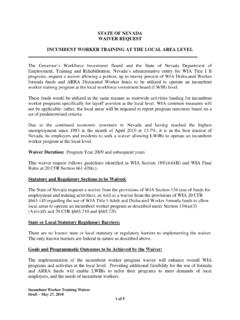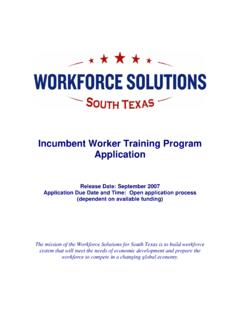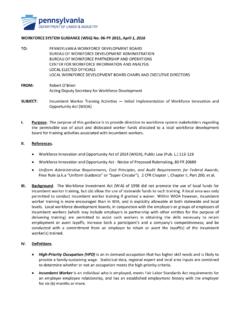Transcription of Missouri Division of Workforce Development Issued: April ...
1 Missouri Division of Workforce Development Issued: April 27, 2018 DWD Issuance 23-2017 Effective: April 27, 2018 Subject: incumbent worker training Policy 1. Purpose: This Issuance describes allowable funding expenditures for work-based training of existing workers, and prohibits duplication of training funds. It rescinds, updates, and supersedes previous guidance on this This Issuance also specifies the formal incumbent worker training (IWT) Agreement that is required between a Local Workforce Development Board (Local WDB) and an employer. 2. Background: The Workforce Innovation and Opportunity Act ( WIOA)2 describes3 allowable training activities, including IWT, a work-based training strategy.
2 IWT is a way to help employees of a company gain the skills necessary for career-advancement opportunities, and to retain employment. 3. Substance: IWT meets the needs of an employer, or a group of employers, by averting potential layoffs, by increasing the skill levels of current employees to make the most of company career-advancement opportunities, and by creating backfill opportunities for less skilled employees. A Local WDB and an employer cannot use IWT for training new hires. For IWT, a Local WDB may use up to 20 percent of the combined total of its Adult and Dislocated worker allotments.
3 This 20 percent must be used exclusively for IWT program activities. IWT administrative activities must be paid for out of the Local WDB s administrative funds. Election to offer IWT. Any Local WDB choosing to implement IWT must first establish an IWT policy as an element in its Local Plan4 before entering any agreement. The Local WDB s requirements and definitions must establish which workers (or groups of workers) and which employers are eligible for incumbent worker services. At a minimum, 5 IWT policies must: Describe the characteristics of participants to be included in the program; 1 DWD Issuance 25-2015, incumbent worker training Policy, June 15, 2016 [herein rescinded].
4 2 Pub. L. 113-128 [29 3101 et seq.]. 3 WIOA Sec. 134 [29 3174]. 4 The Local IWT Policy if there is one is included in the Local Plan as Attachment #16. Guidance and direction on including the Local IWT Policy in the Local Plan was issued in DWD Director s notification letters of provisional Local Plan approval (August 12, 2016). The letters, addressed to the Chief Elected Official and Local WDB Chair for each Local Workforce Development Area (LWDA), outlined three requirements. They were: 1) to include a statement in the Local Plan (yes or no) as to whether or not the LWDA has an incumbent worker program; 2) if yes, to identify the performance targets for the program; and 3) if yes, to detail the Local WDB policy for the Local IWT program.
5 This IWT guidance was issued several months after the release of DWD Issuance 14-2015, Planning Policy and Guidelines for Missouri Local Workforce Development Boards (February 16, 2016), and will be included in the next revision or modification of that policy. 5 Department of Labor, Employment and training Administration training and Employment Guidance Letter (TEGL) 19-16, Guidance on Services provided through the Adult and Dislocated worker Programs under the Workforce Innovation and Opportunity Act (WIOA) and the Wagner-Peyser Act Employment Service (ES), as amended by title III of WIOA, and for Implementation of the WIOA Final Rules, March 1, 2017.
6 Page 2 of 4 Missouri Division of Workforce Development Issued: April 27, 2018 DWD Issuance 23-2017 Effective: April 27, 2018 Establish whether the training improves the labor market competitiveness ofthe employees or both the employees and the employer; The number of employees trained; Wages and benefits; How IWT interacts with other training and advancement opportunitiesprovided by the employer; The results sought with the IWT, such as: credentials attainment, skills gain,layoff aversion, and utilization of sector strategies and career pathways; and Procedures for how employers will pay the required non-federal share of thecost of providing an employer to receive IWT funds, the individual(s) receiving the training must: Be currently employed; Meet the Fair Labor Standards Act requirements for an employer-employeerelationship; Have an established employment history with the employer extending backat least six months (This can include time spent as a temporary or contractworker for the employer.)
7 Exception to the six-month requirement. If IWT is provided to a cohort of employees, not every individual employee in that grouping must have an established employment history with the employer of six months or more. As long as the majority of the employees in the IWT cohort meet the employment-history requirement, employees with shorter histories may be included. IWT program paperwork. The Division of Workforce Development (DWD) strongly recommends that its forms for IWT program management (see References) be utilized for agreements and program management. If forms with local identifiers or headers are used, they must include all information required on the current corresponding DWD form.
8 The form used also must record information in the same format as required on the DWD form. Eligibility differences. An incumbent worker does not have to meet the eligibility requirements for career and training services for Adults and Dislocated Workers. The following is required for IWT eligibility: Employers and their employee trainees must be enrolled into the statewideelectronic case management system; and Documentation must include:oA six- month work history requirement. Local WDBs are required toutilize the DWD incumbent worker training Agreement (or itsequivalent); andoIncreased skills to be obtained by the participant, such as an industry-recognized certificate or credential, or a promotion, that correlates tothe competiveness of the job and the employer; oroProof of averting the need to lay off employees through assistingworkers to obtain the skills necessary to retain employment.
9 Thismust increase both a participant s and a company s competitiveness. training must lead to opportunities for advancement and wage increaseswithin 60 days of the successful completion of 3 of 4 Missouri Division of Workforce Development Issued: April 27, 2018 DWD Issuance 23-2017 Effective: April 27, 2018 Employers are required to pay the non-f ederal share of the cost of providing incumbent working training . WIOA sec. 134(d)(4)(D) requires Local WDBs to establish policies regarding the non-federal share of the cost of IWT. Employers are required to pay a portion of the training for those individuals in IWT.
10 This may be done through cash payments and/or fairly evaluated in-kind contributions. Employer contributions may include the wages the employer pays to the incumbent worker trainee for the hours the worker is actually receiving instruction ( That is, the duration of the training agreement is not used to determine in-kind wage contributions.). The minimum amount of employer share in the IWT depends on the size of employer and may not be less than: 10 percent of the cost, for employers with 50 or fewer employees; 25 percent of the cost, for employers with between 51 100 employees; and 50 percent of the cost, for employers with more than 100 share must be reported on the quarterly ETA-9130 financial report, and costs must be reported in the DWD Financial Reporting System (FRS).












